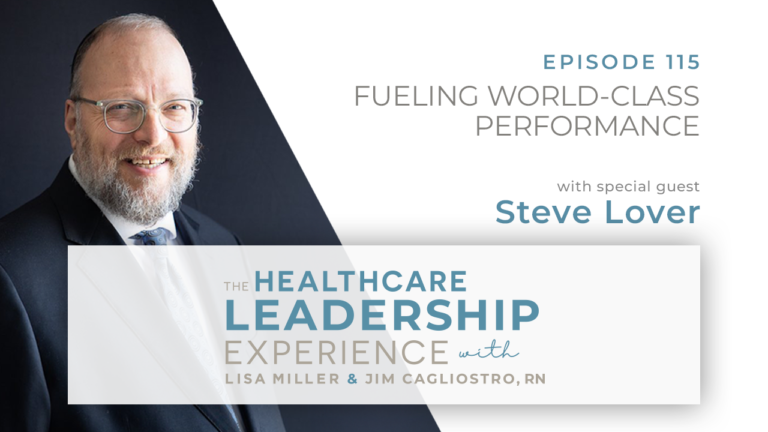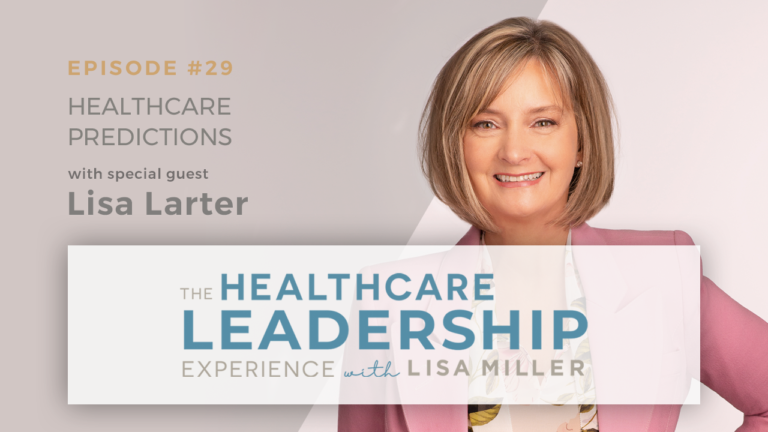There are significant cost savings hiding in hospital med surge reports. VIE regularly sees a 4-6% error rate in the contract reports.
In Episode 44 of The Healthcare Leadership Experience, Lisa is joined by producer Adan Kovinich from The Lisa Larter Group. In today’s episode, Lisa presents five proven areas for cost savings.
As Lisa observes ‘’I can almost guarantee that if you look at these five areas of spend in your organization in the second quarter 2022 you can pull out multi-million dollar cost savings this year for your hospital.’’
This episode is sponsored by VIE Healthcare Consulting® which has proudly helped hospitals save $772 million since 1999.
In This Episode You’ll Hear:
- Why the dollar is in the details. Exploring five key areas for potential cost savings for your hospital: subscription services, professional services fees, equipment repair services, your med surge distribution reports, and physician services
- Taking inspiration from Truebill: the surprising cost savings available in your subscription services and why your GPO agreement is a fantastic place to start.
- A proven framework to identify cost savings in your subscription services – and why these contracts cannot be allowed to automatically renew. ‘’This isn’t like $5000, $75,000, $150,000 in savings, we’re talking $500,000, $800,000, $2 million dollars in cost savings.’’
- Identifying the unused professional services fees hiding in your vendor contracts. ‘’There’s a growing trend to add professional service hourly fees into agreements…We see these buckets of hours not used because they were never needed in the first place.’’
- Why equipment services costs agreements need to be reviewed on a minimum annual basis, and identifying the ‘’double charge’’ in this key area of spend.
- The significant cost savings hiding in hospital med surge reports. Hint, VIE regularly sees a 4-6% error rate in the contract reports.
- The complex nature of outsourced physician services and Joint Venture (JV) agreements, why subsidy agreements must be reviewed every year, and why a JV doesn’t mean a hospital has to overpay.
What To Do Next:
- Subscribe to The Cost Advantage for Healthcare Leaders and receive a special report on 15 Effective Cost Savings Strategies
- Learn more about the simple 3 step process to work with us.
- If you are interested in learning more, the quickest way to get your questions answered is to speak with one of our margin improvement experts. Schedule a call with our team.
Connect with Lisa:
📱 https://www.linkedin.com/in/lisamiller/
Episode Transcripts
CLICK HERE TO DOWNLOAD THE PDF TRANSCRIPT
CLICK HERE TO OPEN THE TRANSCRIPT
Introduction (00:02):
Welcome to the Healthcare Leadership Experience Radio Show with your host, Lisa Miller. Lisa is an entrepreneur, inventor, advisor and founder of VIE Healthcare Consulting, the leading healthcare advisory and analytics firm, helping hospitals accelerate their margin improvement goals. Lisa loves to think differently and collaborates with leaders and their teams to solve challenges and to create new innovative approaches that impact the clinical and business side of healthcare. Our show will bring you leaders and innovators within healthcare and across multiple industries. Be a part of the discussion that will give you a unique perspective, deep insights and roadmaps to successfully help you navigate the clinical, financial, and operations of healthcare. Your show starts now.
Lisa Miller (00:49):
Hello, this is Lisa Miller. And today, I have Adan Kovinich on our show as a producer. Adan, welcome to the Healthcare Leadership Experience Radio Show on HealthcareNOW Radio.
Adan Kovinich (00:20):
Thank you so much for having me. You know, I spend so much time listening to all of your episodes and putting out content for the episodes. So, it’s really great to be on the show.
Lisa Miller (00:31):
Well, it’s going to be an interesting show because, the discussion today will really be around helping hospitals save money, and it would be fascinating to get your feedback on some of the areas that I’ll be sharing from someone who is not in healthcare, but who does a lot of work for VIE, and in other healthcare application. I am a big believer in getting an outside perspective. I think there’s a lot of value when somebody from other industries can take a look in, and have an insight. And I think we need to look more from people outside other industries to give us ideas, or insights, or conversations.
Lisa Miller (01:23):
So today, we’ll be speaking about five proven areas for cost savings. Each one of these has some very specific nuances, and you’ll definitely save money from today’s podcast. That was my goal, to give value, to give a roadmap, and some insights. Because listen, the dollars are in the details, right?
Lisa Miller (02:28):
So, number one is, subscription services. Subscription services are really interesting. And I’m going to take a step to the left for a moment. I don’t know if anyone has heard of Truebill. Truebill is a new app. And basically, this app Their claim to fame or their brand is, “Get control over your subscriptions. Don’t pay for unwanted subscriptions.” You go onto their website, and you see Netflix $17.99, Blue Apron $69.99, Hulu $14.99.
Lisa Miller (02:55):
It’s all about our personal life. Think of that personally, how many subscriptions we have? I know I have a lot. Truebill is fascinating because they are doing personally, what I’m going to talk about and what I talked about for years, about what hospitals can do for their business subscriptions. I kinda give everyone this backdrop of Truebill, because this company has saved over a hundred million dollars for their customers. They have over million canceled subscriptions. That’s a big wow. Adan, had you ever heard of Truebill?
Adan Kovinich (03:28):
I haven’t, but I will be signing up after this, because I am notorious for being annoyed by a pay wall, and just saying, “Forget it, I’ll just pay it.” And then, I may only use it once or twice, and then forget about it. And then, the credit card bill comes in, I look at it, and I’m always shocked, every month at these random subscriptions, I oftentimes don’t even remember subscribing to.
Lisa Miller (03:51):
Right. So, hospitals, today is the day I think that this review of your subscription services begins. It’s a fantastic area. It does take a lot of work, because subscription services are embedded everywhere. They’re embedded in your product purchases or service purchases. They’re very hard to identify. I don’t think most of them attach to the right GL code. I’m going to give you a framework and some things to think about where you could begin.
Lisa Miller (04:23):
Number one, your GPO agreement is a fantastic place to start, with looking at these annual subscriptions, because many times a lot of these subscriptions, they could be some kind of annual analytics, or annual benchmarking reports, or clinical documentation, or some kind of decision analytics. I speak to clients from all over the country. And number one, either they’ve already shared with me, they’re really not using many of these subscription services, but they’re embedded in the agreements, they get paid for by admin fees, or they don’t really see it, they don’t understand it. And some thought they were getting them for free. They may have gotten them for free for their first year, and now they’re recurring, but these annual subscription services and your GPO is a great place to begin.
Lisa Miller (05:12):
The framework works really well. It’s, first of all, understanding how long it’s been in place. Because it gives you context, when you’re really trying to evaluate the other factors. And these other factors are, who uses the subscription? For what purpose? What’s the outcome that you’re trying to achieve by having this subscription? And what’s that future view? The same outcome that you may have wanted a few years ago, that you have today, is it something for the future? Maybe you’ve purchased something or will be purchasing something that will make that subscription obsolete, not necessary.
Lisa Miller (06:00):
I think the number one factor, is it being used? Are you aware of it? And then, is it properly scoped for your service? And, is it priced right? And you need to have this focused effort around subscription service, and I’m telling you when we’ve had clients have us work with them to look at their subscription services. This isn’t like 50,000, 75, 150,000 in savings, which is a lot of money — we’re talking 500, 800, 2 million dollars in cost savings and above, just looking at subscription services. And so first you need to understand the landscape, right? And then second, you need to clean it up. And third, then you got to move to kind of management. This also may require a unique approach.
Lisa Miller (6:44):
We utilize data capture technology. We have patented technology, very specifically on this end data capture technology that can extract subscription services from your invoices and your agreements. And we can elevate this into an Excel and other documents to really start that process of is this being used or did you know this existed? Similar to Truebill does. I mean, they kind of extract that from your bill and now they bring that to your attention and give you the vehicle. They’ll actually cancel the service for you. And we do that as well for our clients. We can facilitate that cancellation according to terms or whatever that may be.
Lisa Miller (7:10):
The second area is professional services fees. And this one’s really interesting because it’s another one that flies under the radar quite a bit. Usually, you’ll see professional services fees as you implement a new technology or just an infusion of work. Whatever reason, you’ve got this project and you need some help. Professional services though has a wide range of pricing.
Lisa Miller (7:40):
And first, you’ve got to take a step back and look at how do we approach this from a framework perspective or price standardization? Because that’s important. The better you can put some standardization around pricing into certain buckets, the better you get your arms around the cost. You’re not to exceed numbers and creating the buckets is the first step, right? So here are a couple of buckets. There’s many more. But there’s a legal bucket. There is an administrative bucket. There’s an IT, and you have one for clinical. Those are four. There are others. So it’s important to be able to understand again where you are. So again, starting with one bucket, let’s start with legal, get your arms around all of your legal professional services fees and really understand historically what you’ve paid in the last 12 months, even the last 24 months. And put that together and you’ll see a lot. You’ll see big ranges, you’ll see a lot of fees.
Lisa Miller (8:50):
And what you’re saying is, listen, we love the legal services that are being provided by your firm, by you, but we want to get some organization, some management around those costs. And here’s where our standardization fees, what we look to have our attorneys pay for these different services. But you’ll also see excessive fees. And you might even see some double charges or things that you didn’t agree to in your contract. But more importantly than anything, this idea around understanding professional services fees is huge because many of the vendors outside of legal are looking to add fees to their agreement. So if they’re implementing a new technology, if they’re having a new service, even supplies, we’re seeing a lot of these professional service fees added because they’re offering some kind of service, may or may not be used.
Lisa Miller (9:44):
And I will tell you what’s interesting, there’s a growing trend to, yes, add professional service hourly fees into agreements. But what’s worse is they’re adding buckets of time. So they’ll say here’s $30,000 worth of professional services hours, or here are 400 hours. And in this last year alone, and we’ve seen this for several years, we see these bucket of hours not used. Not partially used, just not used. They’re not used because they were never needed in the first place. They’re not used because the hospital didn’t know they had this bucket until we came to them and said, listen, you’ve got $40,000 worth of professional hours in your agreement. Have you used them or going through this? And sometimes they don’t even know that it was there.
Lisa Miller (10:30):
So this whole, area of understanding professional services, hourly fees, or any kind of fees, whether it’s administration, it can be project management. We see wide ranges in project management fees. We see wide ranges in IT. Your Epic consultant hourly fee is different than a telecom consultant hourly fee. We’ve seen some telecom consultant hourly fees greater than an Epic consultant fee. So that is number two.
Lisa Miller (10:52):
If you’re just tuning in you are listening to The Healthcare Leadership Experience Radio Show on Healthcare Now Radio and i’m Lisa Miller your host. This show is sponsored by VIE Healthcare Consulting the leading healthcare advisory analytics firm helping hospitals accelerate their cost savings in margin improvement goals. We’ve been helping hospital since 1999 and you can learn more about VIE Healthcare at viehealthcare.com
Lisa Miller (11:19):
All right. Now, number three. The third really proven area for a hospital this year to kind of take out cost is equipment services agreements. Now, I know that that’s usually top of mind for most hospitals. They know they have service agreements for their equipment, and they’ve got a biomed department. They have a third-party agreement to manage the services agreements and they have these individual agreements with the OEM and there’s just a lot going on. So even if you have looked at this in the last year or two, you’ve got a great outsource provider, whatever the case may be… Again, pricing’s important and I list that in this framework as number five, but we’re going to talk about the four other parts of the framework that I think are really, really important and should be done annually, maybe even twice a year.
Lisa Miller (12:14):
Number one, it’s really validating the location of that piece of equipment. That’s important because, you need to know what department your equipment is because once you know the department, then to follow, you could ask questions like, is this being used? Is it being used as a primary piece of equipment? Is it being used as a backup piece of equipment? That’s important because these service agreements have service levels and you could have a platinum, gold, silver parts and material. So if it’s a critical piece of equipment, no question. That should be platinum service, right? No question.
Lisa Miller (12:56):
However, if this is a secondary scope. So you’ve got your primary scopes, let’s say in the GI lab and you have 100 flexible scopes, 80 of them are your primary and you’ve got 20 backup. And definitely on those 80 primary scopes, you need a full full service platinum agreement in place priced competitively. You’re always looking at your utilization on repairs, right? That’s called a consumption analysis, how you’re consuming the service agreement. But if on those 20 you’re paying the same rates, or you’re using the same service rate as those primary, you’re overspending. You don’t need that same service level.
Lisa Miller (13:33):
So we’ve had hospitals that have said, okay, we want to bring those backups down to a silver level, minimal level. We have other hospitals said we don’t want anything on it. We’ll go at risk because we hardly use our backups.
The third area is, believe it or not, are we being double charged for this equipment repair service? So we’ve got hospitals that have paid their OEM for a service agreement and they have a third-party repair company, and it’s on the third-party repair company’s list as well. This is really important to really understand…is there a double charge? There is that percentage of your equipment, unfortunately, that will have a double charge on the service agreements.
Lisa Miller (14:17):
Then we look at price and price is important. Let’s give you an example on something like printers and copiers, where you may not want to have a service agreement on some of those fax machines or some of those lower-end printer machines. It’s just really understanding where’s the value in service agreements. Certainly you don’t want to always be paying top dollar to get items repaired. You want to have a service agreement you can rely on and all the benefits that come from it, but every year, this kind of review to look at all of your equipment and how those service agreements are attached to those equipment. Do you have equipment not being used at all and you’re paying service agreements, or do you have equipment that you can’t even find and you’re paying on that equipment? So that’s a really key area. It does take some work.
Lisa Miller (15:15):
Again, VIE is here certainly to support those projects or really just dedicating your own time and resources to really say, okay, this is a spend area that could be a couple of millions dollars to tens of millions of dollars for a hospital and how do we tackle this? Do we go ahead and say, we’re going to tackle this and we’re going to have a protocol, a framework? We’re going to push this out to those departments. We’re going to push it out to finance, to get a GL report to bio-med, to the vendors. I mean, you can effectively as a hospital, develop a written strategy and push that out to everybody for that data, for that information and then start that collection process. Really have that project manager, that point person that’s able to assemble it, assimilate it, and then begin to analyze.
Lisa Miller (16:01):
And number five, and this is one that again, requires that rolling up your sleeve kind of work. If you’ve noticed really, as I’ve talked about four other areas, this fifth area really is, a the dollars are in the details. It’s taking your Medsurg report. So every hospital has a distributor, a Medsurg distributor, and it’s essentially this huge area spend. However, it’s comprised of thousands of supply items. There’s a lot of people managing the ordering and the price accuracy. There’s a lot that goes into this, because this is a big area spend, but with lots of details and complexities.
Lisa Miller (16:29):
So one of the reports we love to request is a contracting report and really going into the details into this contractor report. I would say in our experience, there are thousands of items in this report, and we see an error rate of 4 to 6%. So on average, around 5% error rate. So think about it. Think about your own spend. If you have a $10 million Medsurg spend with your distributor, or you have a $50 million spend, I mean, think about what a 5% error rate could mean to your organization. So it’s really about getting this report, understanding every single supply item, what contract that’s tied to.
Lisa Miller (17:40):
You’ll see some of those items that have no contracts tied to it. We have some that have local, some that have like old GPO agreements, some that are on the wrong tier. It’s really important for you to see how those items are attached to your specific agreement. And again, it’s just getting that data, getting that right report. If you want to email me, I can give you the name and some of those headers that you can request, but taking that time. We put some of those reports into Microsoft Power BI. So we’re able to run some analytics and run some formulas to identify opportunities, but you can take that report, understand what things are connected to what agreement, what’s not on agreement. It’s so difficult sometimes to see these details on a monthly basis, but if you take time on an annual basis to really run through and perform an audit… which every hospital should run an audit. They will really reap some great opportunities. So that was, I said, number five, but it was number four.
Lisa Miller (18:30):
So finally, I probably have saved probably the most complex to the last, but one that’s really, really super important. That’s around physician service agreements and joint venture agreements. So these agreement reviews, they’re complex. They’re sensitive. There’s not a lot of people who can perform these reviews and it’s just right for hospitals to really lean in and really perform an analysis. So I’m going to go through some of this quickly and just give you again, some ideas, a framework, some things to think about.
Lisa Miller (19:12):
They definitely require an annual review. In fact, because of some of the laws around the physician service agreements and JV agreements around the stark, they want to have hospitals ensure that there’s a competitive financial framework in place. You can’t overspend, overpay on these physician service agreements— whether that’s in compensation, or subsidy, or any kind of earn out. So these agreements do require by law to be reviewed every year and really looked at it from a “does the market support these physician compensation structures, so they do need annual reviews. They do need to be refreshed annually from a benchmarking perspective. Compensation changes, so I can’t say I did a compensation review last year, or the year before. You’ve got to say, “Listen, we’re going to do one annually.” There are different true ups to some of these agreements. These subsidy agreements need to be looked at. We’ve seen a lot of subsidy requests this past year. Some of it makes sense, and some of them are just like, “Okay, we need $500,000 more in a subsidy request,” but that has to be validated. That’s validated through science and data. Why is that? Is there a drop in revenue in their billings? Is there some other kind of issue that requires a subsidy payment?
Lisa Miller (20:26):
And that has to be documented, reviewed annually and listen, it’s also not a long-term payment. Subsidy agreements are meant to be a subsidy for a year and then reviewed next year and the following year and the following year. We’ve seen it where there’s been a subsidy request that just kept in place when in fact that subsidy wasn’t required for a certain year. So, those subsidy requests really need deep analytics and reviews and the physicians also make it other payments, and some agreements may say that those other payments have to be offset by the subsidies that the hospitals require.
So, really if got to look at the full compensation, the full analysis, and many times these agreements and strictly JV agreements have P&L analysis attached, and I can’t tell you how many times that we’ve come across those P&L statements and analysis, and they’ve been wrong or something’s been off.
Lisa Miller (21:32):
And we review it, we reset it, and it has a different financial outcome for the hospital because it’s been analyzed accurately. So, it’s really important that the hospitals also understand that many of these physician groups are getting very sophisticated. They’ve got CFOs, they have negotiation strategies, they’re coming back to hospitals with these counters, and their own analysis that the hospitals now need a team that can help them during this process, and sometimes in this particular area it’s great to have a third party that the hospital has the support system, because yes, it is sensitive. These physicians are key, the groups are key to the hospital. The JV agreements are, but it doesn’t mean a hospital has to overpay, and it doesn’t mean this process has to be a tough time, it doesn’t have to be contentious.
Lisa Miller (22:26):
It just has to be professionally reviewed, professionally discussed, and the hospital needs advocates really to go through this process. So, there’s a couple of final areas as you’re looking at these agreements, certainly again, the P&L reviews are key, addendums to the agreements.
Last year with COVID, we had a lot of additional asks for COVID expenses. Those can’t go into renewal now into 2022 and 2023. Those need to be looked at. There are extra services that get added into the agreement that are not needed, and then how are these services performed?
A lot of these agreements, you can measure the performance of the physicians and the services, and really look to, are they being optimized? And, I think that’s also key. Again, we talk a lot about price benchmarking, but in these cases, you really do need to make sure that they are priced competitively in the compensation structure, but anything additional as it relates to subsidy, as it relates to any kind of distribution, any extra services, these contracts need to be looked at in its entirety.
Lisa Miller (23:40):
So, I’m hoping that everyone got a lot of value out of these five areas for cost savings. They’re diverse, but they certainly can pay dividends. So, I will recap quickly. One is your subscription services, number two would be your professional services fees. Number three, your equipment repair services. Number four, looking at your MedSurg distribution reports and number five your physician services agreements, and I can almost guarantee that if you look at these five areas of spend in your organization here right now in second quarter of 2022, you can pull out a multi-million dollar cost savings for your hospital this year that will transcend into 2023 and going forward.
So, Adan, thank you for being a producer today on our show.
Adan Kovinich (24:38):
It was fun being here. It’s so much fun listening to you talk about it because I can see you’re so passionate about helping hospitals save and find cost saving opportunities. So, it was just fun being here and watching you talk about it.
Lisa Miller (24:48):
So, thank you for being on the show today, Adan, and thank you for those listeners out there who had spent the time with us. And, if you have any questions about VIE, or you want to reach out to me, I’m on LinkedIn and I’m in the show notes, but we love helping hospitals save money, and we’re hoping that this show today was a practical, tactical, and maybe had some strategy for you and ways that you can take and use in your own organization. So, we look forward to having you on other shows.
Outroduction (25:19)
Thank you for joining Lisa Miller for this episode of The Healthcare Leadership Experience Radio Show sponsored by VIE Healthcare Consulting. If you enjoyed the show, subscribe so you can automatically get notified when new shows premiere weekly. Don’t forget to leave us a review so more healthcare leaders like you can discover us. This show is on HealthCare Now Radio, Apple Podcast, Stitcher, Spotify, Pandora, and other major podcast platforms.
To reach out to Lisa personally, you can join the conversation on LinkedIn, where Lisa continues to have discussions on the business of healthcare. You can find links to Lisa’s other social platforms in the show notes or at viehealthcare.com.
The Healthcare Leadership Experience Radio Show is the think differently communication for healthcare leaders, and we are honored to have you tune in. Join us next week for another episode of The Healthcare Leadership Experience Radio Show.











